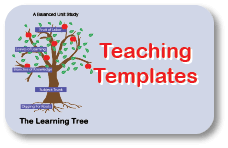
Twenty and Ten Unit Study
Twenty and Ten Unit Study is a literature based study on Claire Bishop's
book for fourth or fifth grade.

Twenty and Ten by Claire Huchet Bishop
Your FREE printer friendly DOWNLOAD of the Ten and Twenty unit study is at the bottom of this page.The Teacher/Leader Answer Key is included.
Introduction to the Twenty and Ten Unit Study
This is the story of twenty fifth grade children in a rural school in France in early 1944, during the German occupation of France. Their teacher, Sister Gabriel, asks the children if they would be willing to help hide 10 Jewish children who are being hunted by German soldiers. Aware of the danger, the children agree.
Make Believe
Twenty and Ten Unit Study Chapter One
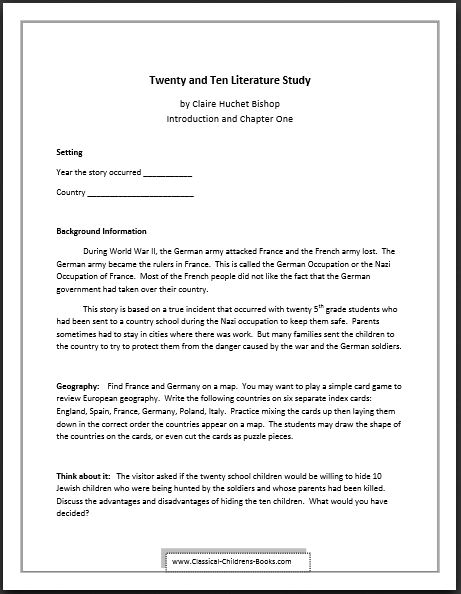
Students should identify the year (1944) and the setting (rural France.)
Provide Background Information
During World War II, the German army attacked France and the French army lost. The German army became the rulers in France. This is called the German Occupation or the Nazi Occupation of France. Most of the French people did not like the fact that the German government had taken over their country.
This story is based on a true incident that occurred with twenty 5th grade students who had been sent to a country school during the Nazi occupation to keep them safe. Parents sometimes had to stay in cities where there was work. But many families sent the children to the country to try to protect them from the danger caused by the war and the German soldiers.
Geography
Find France and Germany on a map.
You may want to play a simple card game to review European geography. Write the following countries on six separate index cards: England, Spain, France, Germany, Poland, Italy. Practice mixing the cards up then laying them down in the correct order the countries appear on a map. The students may draw the shape of the countries on the cards, or even cut the cards as puzzle pieces.
Think about it
The visitor asked if the twenty school children would be willing to hide ten Jewish children who were being hunted by the soldiers and whose parents had been killed. Discuss the advantages and disadvantages of hiding the ten children. What would you have decided?
Gold
Twenty and Ten Unit Study Chapter Two
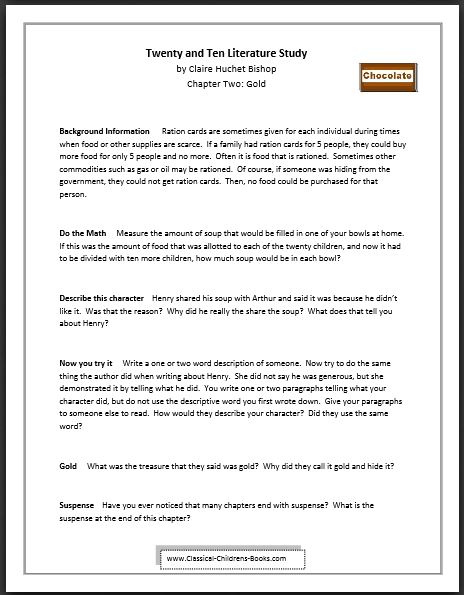
Background Information
Ration cards are sometimes given for each individual during times when food or other supplies are scarce. If a family had ration cards for 5 people, they could buy more food for only 5 people and no more. Often it is food that is rationed. Sometimes other commodities such as gas or oil may be rationed. Of course, if someone was hiding from the government, they could not get ration cards. Then, no food could be purchased for that person.
Do the Math
Measure the amount of soup that would be filled in one of your bowls at home. If this was the amount of food that was allotted to each of the twenty children, and now it had to be divided with ten more children, how much soup would be in each bowl?
Describe this character
Henry shared his soup with Arthur and said it was because he didn't like it. Was that the reason? Why did he really the share the soup? What does that tell you about Henry?
Writing - Your Turn
Write a one or two word description of someone.
Now try to do the same thing the author did when writing about Henry. She did not say he was generous, but she demonstrated it by telling what he did.
Write one or two paragraphs telling what your character did, but do not use the descriptive word you first wrote down. Give your paragraphs to someone else to read. How would they describe your character? Did they use the same word that you did?
Gold
What was the treasure that they said was gold? Why did they call it gold and hide it?
Suspense
Have you ever noticed that many book chapters end with suspense? What is the suspense at the end of this chapter?
The Cave
Twenty and Ten Unit Study Chapter Three
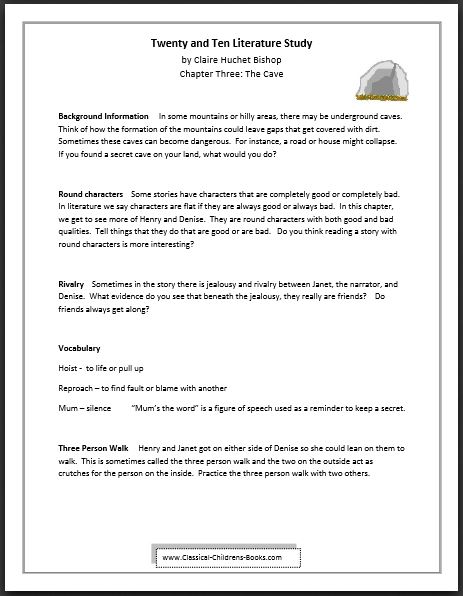
In some mountains or hilly areas, there may be underground caves. Think of how the formation of the mountains could leave gaps that get covered with dirt. Sometimes these caves can become dangerous. For instance, a road or house might collapse. If you found a secret cave on your land, what would you do?
Round characters
Some stories have characters that are completely good or completely bad. In literature we say characters are flat if they are always good or always bad. In this chapter, we get to see more of Henry and Denise. They are round characters with both good and bad qualities. Tell things that they do that are good or are bad. Do you think reading a story with round characters is more interesting?
Rivalry
Sometimes in the story there is jealousy and rivalry between Janet, the narrator, and Denise. What evidence do you see that beneath the jealousy, they really are friends? Do friends always get along?
Vocabulary
Hoist - to life or pull up
Reproach - to find fault or blame with another
Mum - silence
Three Person Walk
Henry and Janet got on either side of Denise so she could lean on them to walk. This is sometimes called the three person walk and the two on the outside act as crutches for the person on the inside. Practice the three person walk with two others.
The Real Thing
Twenty and Ten Unit Study Chapter Four
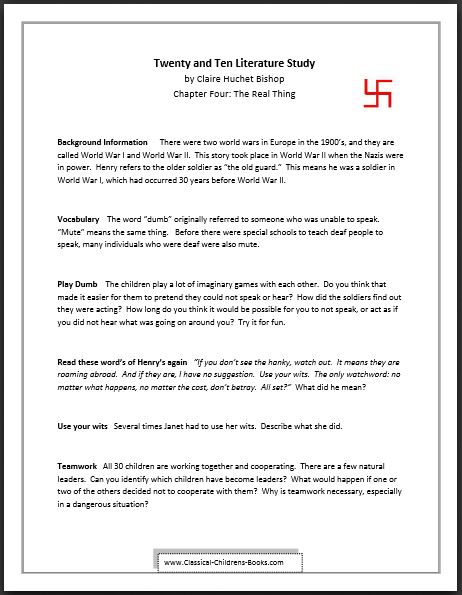
There were two world wars in Europe in the 1900's, and they are called World War I and World War II. This story took place in World War II when the Nazis were in power. Henry refers to the older soldier as "the old guard." This means he was a soldier in World War I, which had occurred 30 years before World War II.
Vocabulary
The word "dumb" originally referred to someone who was unable to speak. "Mute" means the same thing. Before there were special schools to teach deaf people to speak, many individuals who were deaf were also mute.
Pretend
The children play a lot of imaginary games with each other. Do you think that made it easier for them to pretend they could not speak or hear? How did the soldiers find out they were acting? How long do you think it would be possible for you to not speak, or act as if you did not hear what was going on around you? Try it for fun.
Read these word's of Henry's again
If you don't see the hanky, watch out. It means they are roaming abroad. And if they are, I have no suggestion. Use your wits. The only watchword: no matter what happens, no matter the cost, don't betray. All set?
What did Henry mean?
Use your wits
Several times Janet had to use her wits. Describe what she did.
Teamwork
All 30 children worked together and cooperated. There are a few natural leaders. Can you identify which children have become leaders? What would happen if one or two of the others decided not to cooperate with them? Why is teamwork necessary, especially in a dangerous situation?
The Horrible Day Miracle
Twenty and Ten Unit Study Chapter Five
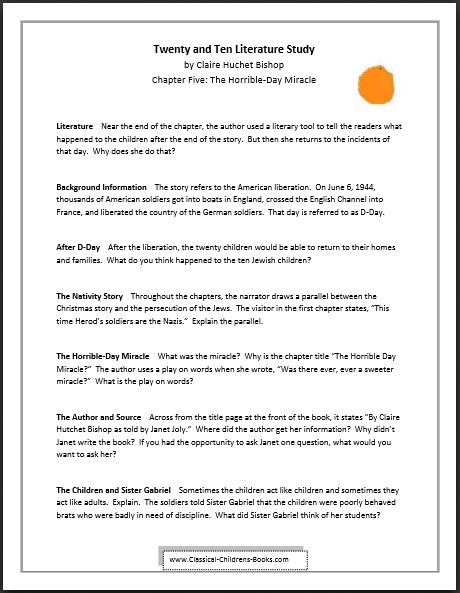
Near the end of the chapter, the author used a literary tool to tell the readers what happened to the children after the end of the story. But then she returns to the incidents of that day. Why does she do that?
Background Information
The story refers to the American liberation. On June 6, 1944, thousands of American soldiers got into boats in England, crossed the English Channel into France, and liberated the country of the German soldiers. That day is referred to as D-Day.
After D-Day
After the liberation, the twenty children would be able to return to their homes and families. What do you think happened to the ten Jewish children?
The Nativity Story
Throughout the chapters, the narrator draws a parallel between the Christmas story and the persecution of the Jews. The visitor in the first chapter states, "This time Herod’s soldiers are the Nazis." Explain the parallel.
The Horrible-Day Miracle
What was the miracle? Why is the chapter title "The Horrible Day Miracle?" The author uses a play on words when she wrote, "Was there ever, ever a sweeter miracle?" What is the play on words?
The Author and Source
Across from the title page at the front of the book, it states "By Claire Hutchet Bishop as told by Janet Joly." Where did the author get her information? Why didn’t Janet write the book? If you had the opportunity to ask Janet one question, what would you want to ask her?
The Children and Sister Gabriel
Sometimes the children act like children and sometimes they act like adults. Explain. The soldiers told Sister Gabriel that the children were poorly behaved brats who were badly in need of discipline. What did Sister Gabriel think of her students?
Free Download of the Twenty and Ten Unit Study
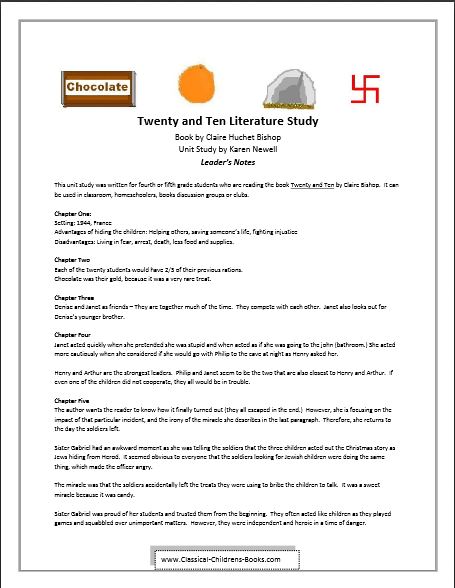
Click to Print the Twenty and Ten Unit Study.
If you found the Twenty and Ten Unit Study helpful, you may wish to view our other unit study pages.


